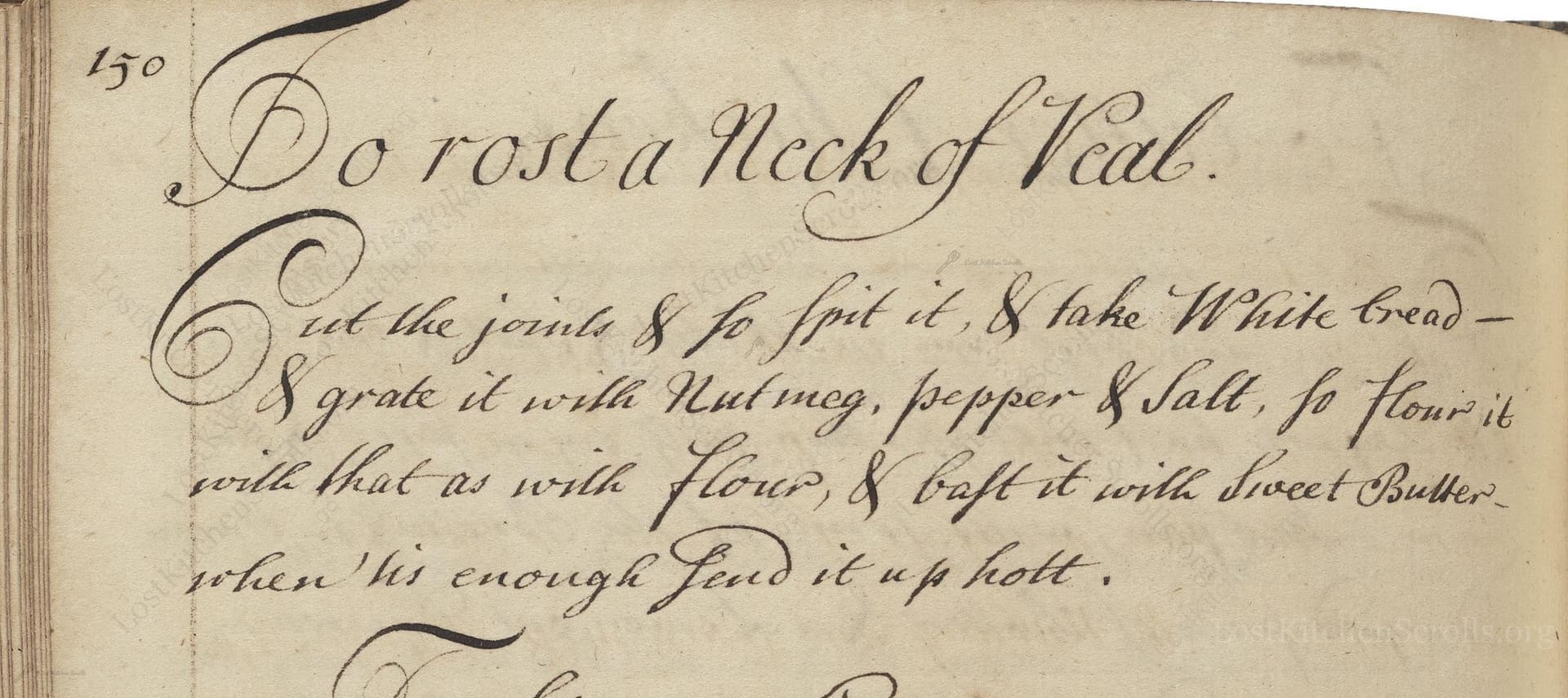To Rost A Neck Of Veal
From the treasured pages of Various Cookeries
Unknown Author

To Rost A Neck Of Veal
"Cut the joints & so spit it, & take White bread – & grate it with Nutmeg, pepper & Salt, so flour it with that as with flour, & bast it with sweet Butter. when ‘tis enough send it up hott."
Note on the Original Text
The recipe is written in the terse, no-frills style typical of the 17th century, expecting the reader to be familiar with common techniques, household measurements, and fire management. Spelling conventions were loose—‘rost’ for ‘roast’, ‘tis’ for ‘it is’—and punctuation and grammar were fluid, often omitting instructional details understood by seasoned cooks of the time. Technical descriptions can be minimal, with directions to 'flour' the meat using the seasoned bread mixture, and no explicit timing for cooking given. Such brevity assumed an audience well-versed in the rhythms and signs of hearth cooking.

Title
Various Cookeries (1690)
You can also click the book image above to peruse the original tome
Writer
Unknown
Era
1690
Publisher
Unknown
Background
A delightful glimpse into late 17th-century kitchens, this book brims with recipes, methods, and culinary wisdom passed down through generations, capturing the essence of historical gastronomy.
Kindly made available by
Folger Shakespeare Library
This recipe dates from the late 1600s, a period known for its lavish meat roasts and skilled kitchen techniques in aristocratic and urban households of England. Cookbooks and manuscripts of this era favored simple preparations that let the quality of meat shine, supplemented by aromatic spices—like nutmeg, which was a luxury at the time. The instruction to thoroughly baste with butter reflects both the wealth of the household (butter being a valuable ingredient) and the emphasis on moist, richly flavored roasts. Grated bread was a popular textural element, and seasoning with nutmeg, pepper, and salt would have given a subtly spicy, aromatic crust to the juicy veal.

Historically, the dish was made using a roasting spit—either hand-turned or operated with a clockwork mechanism—suspended before an open hearth fire. Supporting tools included a sharp knife for jointing, a grater for bread and perhaps for nutmeg, and basting brushes or cloths for applying butter. Large platters and trenchers were used for serving, and cooks often roasted directly over embers or before a reflected heat source for best results.
Prep Time
20 mins
Cook Time
1 hr 45 mins
Servings
6
We've done our best to adapt this historical recipe for modern kitchens, but some details may still need refinement. We warmly welcome feedback from fellow cooks and culinary historians — your insights support the entire community!
Ingredients
- 3.3-4.4 lbs neck of veal (substitute: neck of lamb if veal unavailable)
- 3.5 oz white bread, grated (fresh or slightly stale)
- 1 tsp ground nutmeg
- 1 tsp black pepper, freshly ground
- 2 tsp fine salt
- 3.5 oz unsalted butter, melted
Instructions
- Start by taking a veal neck, approximately 3.3 to 4.4 lbs, and cut between the vertebrae joints to allow for easier roasting and serving.
- Thread or skewer the meat securely onto a rotisserie spit or onto a rack for oven roasting at home.
- In a bowl, grate about 3.5 oz of fresh white bread.
- Mix this with 1 teaspoon of ground nutmeg, 1 teaspoon of freshly cracked black pepper, and 2 teaspoons of salt.
- Use this seasoned bread mixture as a coating, dusting the veal neck thoroughly as you would with plain flour.
- Begin roasting the veal in a preheated oven at 350°F, or over an open fire if you have a spit.
- Baste generously with 3.5 oz of melted unsalted butter throughout roasting, particularly after each turning.
- Roast until the meat is tender and browned—about 1.5 to 2 hours, depending on thickness.
- Serve hot, straight from the oven or spit.
Estimated Calories
520 per serving
Cooking Estimates
Preparing the veal neck and seasoning takes about 20 minutes. Roasting in the oven usually takes 1.5 to 2 hours, depending on the size of the meat. This recipe serves about 6 people, with around 520 calories per serving.
As noted above, we have made our best effort to translate and adapt this historical recipe for modern kitchens, taking into account ingredients nowadays, cooking techniques, measurements, and so on. However, historical recipes often contain assumptions that require interpretation.
We'd love for anyone to help improve these adaptations. Community contributions are highly welcome. If you have suggestions, corrections, or cooking tips based on your experience with this recipe, please share them below.
Join the Discussion
Rate This Recipe

Den Bockfisch In Einer Fleisch Suppen Zu Kochen
This recipe hails from a German manuscript cookbook compiled in 1696, a time whe...

Die Grieß Nudlen Zumachen
This recipe comes from a rather mysterious manuscript cookbook, penned anonymous...

Ein Boudain
This recipe comes from an anonymous German-language manuscript cookbook from 169...

Ein Gesaltzen Citroni
This recipe, dating from 1696, comes from an extensive anonymous German cookbook...
Browse our complete collection of time-honored recipes



